
HOME
INTRO
SYMBOLS
ALMANAC
ECONOMY
GEOGRAPHY
STATE MAPS
PEOPLE
GOVERNMENT
FORUM
NEWS
COOL SCHOOLS
STATE QUIZ
STATE LINKS
BOOK STORE
MARKETPLACE
NETSTATE.STORE
NETSTATE.MALL
GUESTBOOK
CONTACT US

South Dakota State Insect: Honey Bee
Photographs, posters, prints
South Dakota Law
The following information was excerpted from the South Dakota Codified Laws , title 1, chapter 1-6, section 1-6-14.
TITLE 1 STATE AFFAIRS AND GOVERNMENT
CHAPTER 1-6 STATE EMBLEMS
1-6-14 State insect.
1-6-14. State insect. The honey bee, Apis Mellifera L, is hereby designated as the official insect of the State of South Dakota.
Source: SL 1978, ch 5, § 1.
Sources...
The State of South Dakota. South Dakota Codified Laws. Pierre: State of South Dakota. Web. 12 Jul 2011. .
Shearer, Benjamin F. and Barbara S. State Names, Seals, Flags and Symbols: A Historical Guide Third Edition, Revised and Expanded. Westport, Conn: Greenwood Press, 3 Sub edition, 2001.
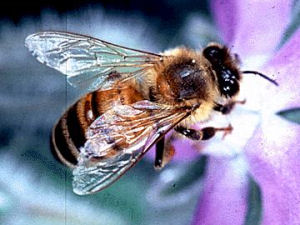
South Dakota State Insect: Honey Bee
Photographs, posters, prints
Additional Information
Apis mellifera, honey bee: BioKIDS Critter Catalog from a partnership of the University of Michigan School of Education, University of Michigan Museum of Zoology, and the Detroit Public Schools.
Apis mellifera honey bee: The University of Michigan Museum of Zoology: Animal Diversity Web.
Apis mellifera - Linnaeus, A Honeybee: A network connecting science with conservation - NatureServe Explorer: An Online Encyclopedia of Life.
Apis mellifera Linnaeus, 1758: Integrated Taxonomic Information System (ITIS) Here you will find authoritative taxonomic information on plants, animals, fungi, and microbes of North America and the world.
State insects: Complete list of official state insects from NETSTATE.COM.
More symbols & emblems: Complete list of official South Dakota state symbols from NETSTATE.COM.
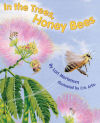
In the Trees,
Honey Bees
Lori Mortensen
In the Trees, Honey Bees, by Lori Mortensen. 32 pages. Publisher: Dawn Publications (March 1, 2009) Reading level: Ages 4-8. Here is the ideal introduction for preschoolers and early elementary children to insects that are not only amazing but also critically important to humans. Inside-the-hive views of a wild colony of honey bees offer close-ups of the queen, the cells, even bee eggs. Simple verse will engage a young child, while sidebars with fascinating information satisfy the somewhat older child. Parents, teachers, and interested children will enjoy much more information about both wild and domestic hives in the back of the book. The artist’s detailed style shimmers with life, highlighting each hair or grain of pollen on the bees. A wild hive in a tree in the artist's own backyard served as a model.
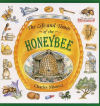
The Life and Times
of the Honeybee
Charles Micucci
The Life and Times of the Honeybee, by Charles Micucci. 32 pages. Publisher: Sandpiper (August 25, 1997) Reading level: Ages 4-8. This witty and informative salute to the honeybee uses clear, lively text and detailed full-color illustrations to present a wide range of interesting, and sometimes amusing, facts about the life cycle, work, and history of one of the world's most useful insects.
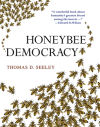
Honeybee Democracy
Thomas D. Seeley
Honeybee Democracy, by Thomas D. Seeley. 280 pages. Publisher: Princeton University Press (September 20, 2010) Honeybees make decisions collectively--and democratically. Every year, faced with the life-or-death problem of choosing and traveling to a new home, honeybees stake everything on a process that includes collective fact-finding, vigorous debate, and consensus building. In fact, as world-renowned animal behaviorist Thomas Seeley reveals, these incredible insects have much to teach us when it comes to collective wisdom and effective decision making. A remarkable and richly illustrated account of scientific discovery, Honeybee Democracy brings together, for the first time, decades of Seeley's pioneering research to tell the amazing story of house hunting and democratic debate among the honeybees.
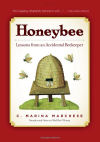
Honeybee
C. Marina Marchese
Honeybee: Lessons from an Accidental Beekeeper, by C. Marina Marchese. 256 pages. Publisher: Black Dog & Leventhal Publishers; First Edition edition (September 1, 2009) In 1999, Marina Marchese fell in love with bees during a tour of a neighbor's honeybee hives. She quit her job, acquired her own bees, built her own hives, harvested honey, earned a certificate in apitherapy, studied wine tasting in order to transfer those skills to honey tasting, and eventually opened her own honey business. Today, Red Bee® Honey sells artisanal honey and honey-related products to shops and restaurants all over the country.
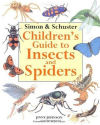
Children's Guide to
Insects and Spiders
Jinny Johnson
Simon & Schuster Children's Guide to Insects and Spiders , by Jinny Johnson. 64 pages. Simon & Schuster Children's Publishing (May 1, 1997) Reading level: Ages 4-8. A detailed introduction to spiders and insects contains information about every major group of arachnids and insects, hundreds of thought-provoking facts, and full-color pictures and photographs."
Eyewitness Workbooks: Insect, 48 pages. DK CHILDREN; Workbook edition (June 16, 2008) Reading level: Ages 4-8. Perfect for getting ahead at school or just stimulating children's interest, this groundbreaking series of workbooks leaves the competition in the dust, with exciting subjects, 48 full-color pages, a turn-and-learn info wheel, and special carrying folders. This book helps kids take their knowledge of insects to the next level, from battling beetles to buzzing honeybees.

Garden Insects of North America
by Whitney Cranshaw
Garden Insects of North America: The Ultimate Guide to Backyard Bugs, by Whitney Cranshaw. 672 pages. Princeton University Press (March 8, 2004) Garden Insects of North America is the most comprehensive and user-friendly guide to the common insects and mites affecting yard and garden plants in North America. In a manner no previous book has come close to achieving, through full-color photos and concise, clear, scientifically accurate text, it describes the vast majority of species associated with shade trees and shrubs, turfgrass, flowers and ornamental plants, vegetables, and fruits--1,420 of them, including crickets, katydids, fruit flies, mealybugs, moths, maggots, borers, aphids, ants, bees, and many, many more.
Smithsonian Handbooks: Insects, by George C. McGavin. 256 pages. DK ADULT; 1st edition (October 1, 2002) Packed with over 650 crystal--clear photographs and illustrations with precise annotation to make identification sure and simple. Authoritative text, crystal--clear photography, and a systematic approach make this handbook the most comprehensive recognition guide to the insects, spiders, and other terrestrial arthropods of the world.
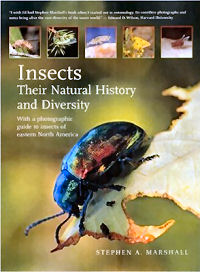
Insects by Stephen A. Marshall
Kaufman Field Guide to Insects of North America, by Eric R. Eaton, Kenn Kaufman. 392 pages. Houghton Mifflin Harcourt; 1 edition (February 28, 2007) In the new Kaufman Field Guide to Insects of North America, readers will find a wealth of information on the amazing observable behaviors of insects and their fascinating life histories. Naturalists Kenn Kaufman and Eric R. Eaton use a broad ecological approach rather than overly technical terms, making the book accessible and understandable for everyone. The guide is lavishly illustrated, with more than 2,350 digitally enhanced photographs representing every major group of insects found in North America north of Mexico.
National Wildlife Federation Field Guide to Insects and Spiders & Related Species of North America, by Arthur V. Evans. 496 pages. Sterling (May 31, 2007) National Wildlife Federation's new all-photographic field guide to North American insects, spiders, and related species, is the most up-to-date of its kind, and lets both amateur and expert naturalists identify more than 940 species quickly and accurately. More than 2,000 close-up color photographs by leading nature photographers reveal the field marks that distinguish each creature, and the clear and concise text that accompanies each image describes the range, habitat, life cycle, and behavior.
Insects: Their Natural History and Diversity, by Stephen A. Marshall. 736 pages. Firefly Books; Updated edition (June 2006) Meticulously researched and illustrated with color photographs, Insects is a landmark reference book that is ideal for any naturalist or entomologist. To enhance exact identification of insects, the photographs in this encyclopedic reference were taken in the field -- and are not pinned specimens.



